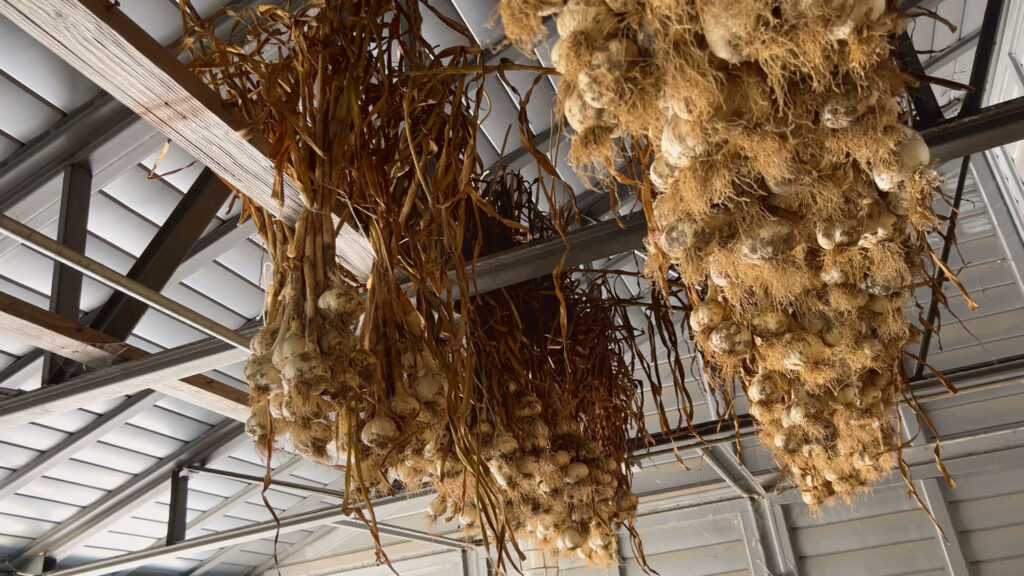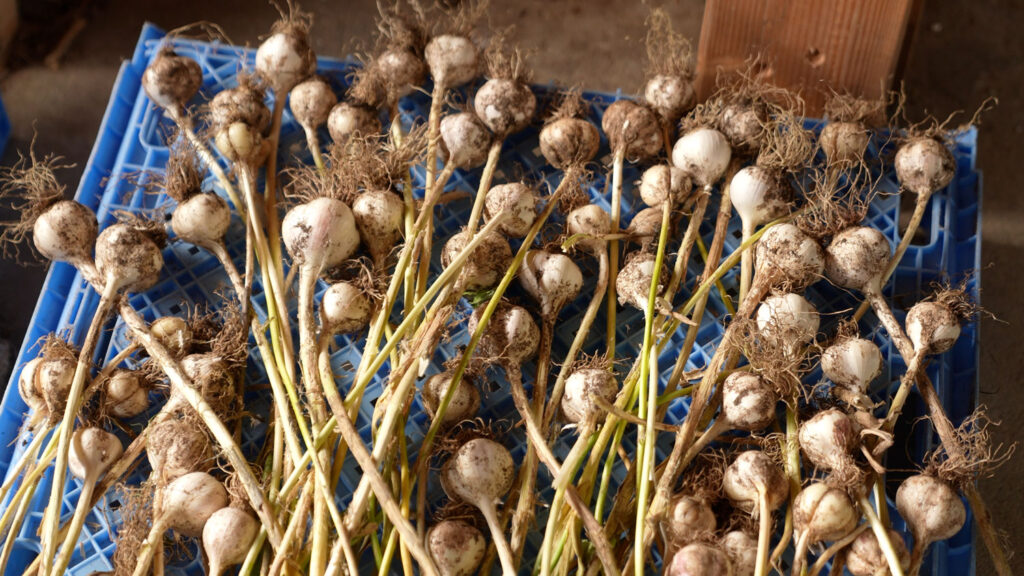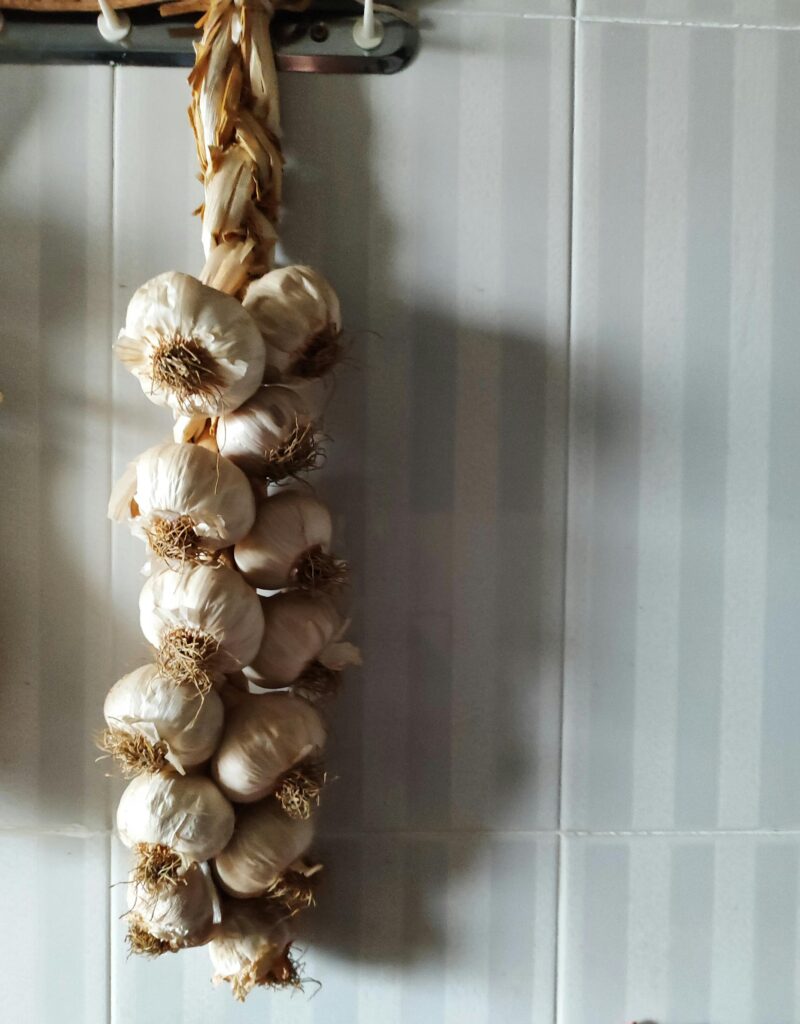Knowing how and when to harvest your garlic crop doesn’t mean your garlic growing season is over! An essential step in the process is to make sure you cure your garlic bulbs properly, setting them up for successful long-term garlic storage. Knowing how to cure garlic after the garlic planting season will let you enjoy the fruits of your labor for months to come, so let’s look at the best way to dry garlic bulbs and prepare them for the cold season ahead.

Why Should You Cure Garlic After Harvest?
If you’re wondering how to store garlic long term, curing garlic is the answer. The difference between cured and uncured garlic lies in its storage potential. If garlic is not cured, it must be used quickly, or you run the risk of mold, fungal, and bacterial growth, resulting in rot. Curing is the process of letting the garlic bulb dry appropriately, and cleaning it in preparation for this procedure.
How to Clean Garlic for Curing
Cleaning garlic for curing helps remove pathogens that can threaten your crop (and makes it look nicer too!). How to clean a garlic clove for curing is a relatively simple process. One way to get clean garlic bulbs is to remove the lowest leaf from the stem. This should pull the outside layer of the bulb, and any dirt and debris, away with it, leaving you with a nice white bulb. However, it is important to do this within an hour or so of harvest before the leaves dry and toughen.
You don’t want to use water to wash garlic for curing! Remember, we discussed in our garlic watering blog that too much moisture at harvest time is a no-no. Excess water makes it easy for many pathogens to thrive.
I like to use a stiff brush to remove any excess dirt from the bulb—don’t forget the roots! And it’s not just about how to clean your garlic bulbs, the stem is important too! If you are curing in a way that utilizes the stem, like braiding, you can leave it intact. If you plan to lay your garlic on a screen or mesh, you can trim the stem to about 6 inches in length.
Bunch & Hang Garlic to Cure
I like to place my garlic into bunches to prepare it for curing. Each garlic bundle may vary in size depending on the size of your bulbs, but I typically put around 6-8 stems together and tie them a few inches above the bulbs with twine. You want to bunch garlic in amounts large enough to make it efficient, but you also want to make sure you allow for plenty of airflow to give your bulbs proper curing potential. The bunches can then be hung to cure.
Drying Garlic on Screens

If you don’t have the space for hanging garlic to cure, you can also lay it out flat on a breathable surface, such as screening, mesh, a large plastic crate turned upside down, or similar ventilated platform.
Braiding Garlic to Cure
While I am not an expert at how to braid garlic for drying (I tried once, and it’s nothing like braiding my hair!), some growers make a garlic rope or garlic wreath, braiding their garlic to cure. A garlic braid is so pretty and can be an effective way to hang and cure your crop.

Where to Cure Garlic
Our founder, April, chooses her garage, and I use the rafters of my hay barn, but the best place to dry garlic might not be either of those options for your bulbs. You might have several locations available that could make the cut as the best place to cure garlic. Whichever location you choose, whether you are curing garlic indoors or choose to cure garlic outside, your site must have certain attributes.
Your curing garlic temperature should not be above ninety degrees, and avoid freezing temperatures. The bulbs should be out of direct sunlight. Good airflow is a must. If you are curing inside, such as curing garlic in the basement, you need to make sure you have adequate ventilation. You may choose to use fans to boost airflow. The air should be dry, and excess moisture, like condensation or rain, excluded from the area.
If you’ve cured garlic before, where have you had the best results? Let us know in the comments!
How Long to Cure Garlic
Curing garlic takes about three weeks, but may vary slightly depending on your condition. Rather than using a time frame to determine how long you cure garlic, use visual observations to determine whether or not your garlic has completed its cure.
How to Tell Garlic is Done Curing
There are a few key ways to determine that the curing is finished. Your dry garlic should have little to no green left inside the stem, and the stem will be hard. The cured garlic will have a constricted neck, and the garlic skin will appear dry and papery. This appearance should be uniform. The bulbs should easily crack open. Before you store your garlic, give each bulb a close inspection, and remove any that show signs of rot or disease.
How to Store Garlic
Garlic should be stored in similar conditions in which it was cured. Unlike garlic scapes, which should be refrigerated, it is not necessary to refrigerate cured garlic. Airflow should be good among the stored bulbs, and the relative humidity should be low. Lower temperatures (though not freezing) will keep your harvest fresher longer, as will darkness.
The bulbs will need to “breathe” (remember, air flow!) so the container you choose to store them in shouldn’t be sealed. I use a milk crate, an onion bag or similar mesh bag is another great option. Stay away from plastic bags or glass, which can trap moisture and encourage mold growth.
If you don’t have time or space to properly cure your garlic, there are some ways to store fresh garlic. You can preserve fresh garlic by canning garlic, pickling garlic, making garlic vinegar, or storing garlic in oil.
You’ve made it this far, so make sure you put the effort into curing your garlic effectively! The home gardening adventure doesn’t end at harvest, and properly cured garlic ensures that the fruits of your labor will last you into next season. Mine never does, not because it isn’t properly cured, but because homegrown garlic is the key ingredient in just about every food we make! Keep following along with our garlic series to maximize your beautiful bulbs.
Sources:
- Garlic Harvest, Curing & Storage, University of Massachusetts Amherst
- Harvesting Garlic, Colorado State University Extension
- Storing Garlic, Keene Garlic
- Curing Garlic, Keene Garlic


Leave a Reply